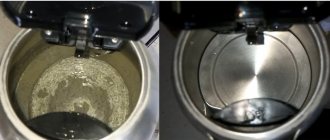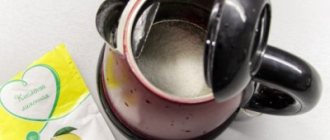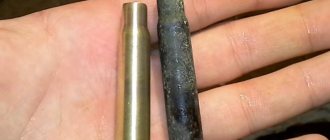This is due to impurities present in the water, which form scale when heated.
It is quite possible to cope with such sediment. We will tell you in this article how to remove scale from an enamel kettle at home.
TOP 3 special means
In addition to simple home recipes, you can use cleaning products sold in household chemical departments .
Antiscale Chistin
Anti-scale is a product that is intended to remove lime deposits on dishes and electric heating devices. This drug is produced in Russia. Release form: small, 75 gram sachets, designed for single use.
In order for Antiscale to work, it is necessary to carry out the following work:
- the powder is diluted in 1 liter of warm, about +40°C, water;
- the resulting solution is poured into the kettle;
- leave for half an hour;
- The kettle is washed in running water.
The cost of 1 sachet is about 40 rubles.
SonixBIO
The drug produced in the Czech Republic is available in liquid form. This is a biodegradable product. Available in 0.25 l packs.
Application procedure:
- Pour 1 liter of water into the kettle.
- Pour in SonixBIO (100 to 120 ml), depending on the severity of the situation.
- Preheat to +50°C.
- Leave for half an hour.
- Drain the solution.
- Wash the inside.
Price - about 120 rubles per bottle.
Un Momento Capsules Antiscale
The product is produced in the Russian Federation. One package contains 5 capsules, each of which is designed for 1 use. Each contains a 10 ml liquid concentrate. This is a non-toxic drug that is convenient to use - it cannot be scattered or spilled.
Application procedure:
- pour 1 liter of water into the kettle;
- place the capsule inside;
- boil;
- set aside for 60 minutes;
- Rinse.
Packaging price – from 120 rubles.
How to remove scale from an enamel kettle using folk recipes
There are three options for descaling an enamel kettle at home:
- mechanical cleaning;
- using household chemicals;
- using home recipes.
The easiest and most accessible method is mechanical . To do this you will need a wire brush and cleaning paste. Intense friction can remove even the most stubborn hard deposits on the walls of the kettle. But this method also has disadvantages:
- mechanical impact on scale requires a lot of force and a lot of time;
- along with the plaque layer, there is a risk of removing the coating or creating cracks;
- In defects caused by mechanical cleaning, scale is fixed, and it is then even more difficult to remove it.
Therefore, in order not to damage the device, but at the same time effectively deal with lime deposits, it is recommended to use folk recipes .
Lemon acid
This product is a leader in the fight against lime on the walls of kitchen appliances . It dissolves perfectly, does not contain toxins and effectively removes hard plaque.
The instructions are extremely simple:
- Dilute 5 tbsp. l. acid in 2 liters of water.
- Boil the kettle.
If the desired result was not achieved the first time, repeat boiling with citric acid. But before you drain the used solution from the kettle, wait and let it cool, otherwise the enamel may crack. As soon as the limescale deposits begin to come away from the walls and bottom, wash the appliance with a soft sponge.
Important! To wash out any remaining acid, boil clean water in a kettle 2 or 3 times.
Vinegar
Acetic acid effectively breaks down solid deposits.
You can get rid of scale in an enamel kettle using vinegar like this::
- Dilute 1 tbsp. 9% vinegar in 2 liters of cold water.
- Let the mixture sit for 30-40 minutes.
- Boil for 5-10 minutes.
- Drain the liquid and rinse the kettle under running tap.
- Boil it with fresh water several times.
The main disadvantage of this method is the strong vinegar smell.
Baking soda
An affordable and safe way to remove old limescale is baking soda. It does not affect the enamel, but the product should be used carefully so as not to scratch the walls:
- Dilute 1 tbsp. l. soda in two glasses of water.
- Bring the mixture in the kettle to a boil and simmer for 30-35 minutes.
- Let the liquid cool, then drain it.
- Clean the device.
Vinegar with soda
Solid deposits can be removed by mixing a vinegar solution with baking soda:
- First, boil a water solution of soda in a kettle, as indicated in the previous recipe.
- Drain it and boil the device with a vinegar solution.
- Clean the kettle with a foam sponge and boil with clean water.
Coca Cola
The carbonated drink “Coca-Cola” (“Sprite”, “Fanta”) will help to clean the enamel device from a layer of scale.
Mode of application :
- Fill the kettle with soda halfway.
- Boil it.
- Let stand for 20-30 minutes.
- Drain the contents and rinse the inside thoroughly with clean water.
Peel
Potato peels contain a large amount of organic acids that will help remove plaque in an enamel kettle:
- Peel two potato tubers.
- Pour water over the peel and boil slowly for 1-1.5 hours.
- Drain the liquid and clean the walls with a soft sponge.
You can use apple or lemon peels instead of potato peels.
Cucumber solution
Despite the not very pleasant aroma, the cucumber solution copes with lime deposits on the walls quite well:
- Pour the solution up to the middle of the kettle.
- Boil and let it cool.
- Drain the liquid and thoroughly clean the inside surface.
Lemon
An easy but effective way to get rid of plaque on the walls of a kettle:
- Cut the citrus into slices.
- Fill the kettle with water 2/3 full and add chopped lemon.
- Boil for 30 minutes.
- Remove the teapot from the heat and let the solution cool.
- Drain the lemon water and clean the bottom and sides with a regular washcloth.
How to clean the outside of an enamel kettle
Dirt on enamel teapots appears not only inside, but also outside. Food water will help to cope with stains :
- Mix 2 tbsp. l. soda with water until the consistency of gruel.
- Apply the mixture to a soft sponge soaked in water and gently wipe the kettle.
- Rinse the device with tap water.
Preventive measures
It is almost impossible to completely prevent scale from appearing in a kettle. Even in purchased water, or in water that has passed through home filters, there is a certain amount of salts, which, when boiled, form carbon dioxide and insoluble sediment in water.
Preventive measures include the following:
- For boiling, it is advisable to use only purified soft water. Hard water is not only harmful to health, but also forms a large amount of scale.
- Regularly washing the inside of an enamel kettle will help prevent the formation of dense layers of scale. This will allow you to remove plaque while it is loose.
- Constantly adding water to the container remaining from the previous time will contribute to the rapid formation of limescale deposits. The solution to the problem is to rinse the kettle before pouring fresh water into it.
- Repeated boiling of the same water is not advisable.
Scale in an enamel kettle - a problem or not
In our country, hard water flows from the tap almost everywhere. The reason is the presence of magnesium and calcium salts in it. When such water is heated, the salts begin to interact and then disintegrate. As a result, a white or yellowish coating appears in the electrical appliance, which affects the quality of the water and gives it an unpleasant taste.
During subsequent boiling, the scale breaks off from the walls and falls into the liquid in pieces. Even the smallest particles of sediment, once in the body, clog the intestines and cause many diseases .
Interesting things on the site:
How to descale pots at home
How to clean spoons and forks until they shine
How to clean dishes from carbon deposits and old fat
Household chemicals to combat scale
It is not recommended to remove plaque from kitchen utensils with aggressive limescale removers. For household appliances and dishes, there are special products with a similar effect :
- descaling liquid “Antinakpin” of the “Cinderella” series;
- Anti-scale powder for teapots.
Both products contain sulfamic acid and ammonium and have a gentle effect on enamel. The products must be used according to the instructions; for enamel coatings, the volume of water can be increased by 1.5 times. It is recommended to carry out the cleaning procedure no more than three times a month.
Precautionary measures
In order not to “treat” a burnt teapot, you must follow a number of simple rules:
- first pour water into the container, and only then put the kettle on the burner;
- do not leave any objects on the stove unattended;
- If you cannot accustom yourself to discipline, you will have to abandon stove-top models and use electric kettles with automatic shut-off.
We must remember that forgetfulness is dangerous and can result in serious problems (fire, smoke). Be careful and careful in everyday life, and then no force majeure will arise.
Advanced cases, if the plaque does not go away
Unlike stainless steel or glass, the enamel coating cannot be rubbed with force. It is better to use chemical cleaning agents using household or industrial detergents. Boiling a soda solution will help remove plaque: add up to 2 tablespoons of sodium bicarbonate per liter of water. “Acid boiling” gives good results; per liter of water you need 1.5 cups of 6% vinegar.
There are other folk remedies to combat limescale:
- Citric acid is milder than vinegar. The plaque is smeared with a mixture of soda and citric acid, it foams and destroys the plaque to the ground. After this treatment, rinse the dishes well. Small dark spots are moistened with a solution of citric acid and left for 2–3 hours to destroy the plaque. Cleaning such a kettle will be much easier;
The plaque is smeared with a mixture of soda and citric acid, it foams and destroys the plaque to the ground. - Natural apple cider vinegar used to treat old enamel. Malic acid acts mildly and dissolves carbonates well. If you add a little soda to it, a violent reaction will begin with the formation of a large amount of oxygen.
Malic acid acts mildly and dissolves carbonates well.
Fighting scale with chemicals is a last resort. Getting into microcracks, aggressive components gradually destroy the enamel coating. To preserve it, you need to promptly remove the limescale layer.
Having an enamel kettle at home, it is important to follow the basic rules for its operation.
Having an enamel kettle at home, it is important to follow the basic rules for its operation. Rather than fight plaque using household chemicals or folk remedies, it is better to prevent scale from forming on the dishes.
Mechanical cleaning
This method is quite simple: you just need to use an abrasive brush. This could be a steel wool, river sand, or the hard side of a dish sponge. Using the mechanical method, you can quickly get rid of even the most stubborn deposits, but there are also disadvantages:
- The process is very labor-intensive and will require a lot of time and effort.
- When removing plaque, you can easily scratch the surface. A rough, not perfectly smooth surface will no longer have the effect of novelty.
- In the future, microcracks will become even more clogged, and it will become increasingly difficult to remove them.
Preventing the appearance of scale in an enamel kettle
Fighting plaque takes a lot of time. There is a possibility of damaging the enamel or creating cracks. Therefore, it is easier to prevent the appearance of limestone deposits by following simple recommendations :
- regularly wash the inside of the kettle, wiping it dry with a sponge at the end;
- do not boil tap water;
- Ideally, use melt or spring water, or, in extreme cases, filtered or bottled water;
- do not boil too much water at once so that you do not have to reheat it - drain unused but boiled water from the kettle;
- After each boiling, rinse the kettle with water, removing plaque on the walls.
The enamel will last a long time if you clean it in a timely manner . At the first signs of darkening, the device is thoroughly washed and clarified with vinegar solution or another food acid.
Never leave water in an enamel kettle overnight, since if the device dries completely, the risk of plaque will be significantly reduced.
Advice. Every month, boil water in a kettle with the addition of 1 tbsp. l. citric acid for prevention.
Enamel dishes can be washed in the dishwasher - it is recommended to load the device at high temperature at least once every 1-2 weeks.











